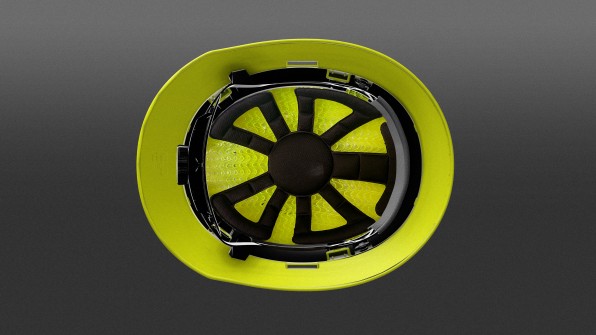Made with a material called WaveCel, the hard hats aim to greatly reduce traumatic brain injuries on construction sites.

The plastic hard hat is one of the most recognizable pieces of equipment on any construction site. That’s partly because of safety regulations that require workers to wear them. But it’s also because for the last half century, the design of the hard hat has hardly changed.
That might be an indication that the hard hat is fine as is (if it ain’t broke, don’t fix it). But the protection hard hats provide calls into question the strength of that classic design. The construction industry has one of the highest rates of occupational traumatic brain injury, or TBI, in the U.S., which sees nearly 2 million such injuries every year. One study found that construction industry workplace deaths due to traumatic brain injury made up 25% of all workplace TBI deaths.

Their redesigned hard hat uses a new material called WaveCel, a collapsible grid of honeycomb-shaped plastic that forms a protective layer beneath the dome of the hard hat. Instead of just protecting wearers from direct hits on the crown of the head, the new hard hat—the WaveCel T2+ Pro—provides protection from the lateral impacts that workers suffer far more commonly on construction sites, such as banging into a steel beam, slipping and falling, or getting knocked by moving construction materials.
“Like when a boxer gets knocked on the chin, you spin the head, you drop like a fly,” says biomechanical engineer Michael Bottlang, cofounder of WaveCel, based in Wilsonville, Oregon. “In slow motion you see the nose is getting pulled one way, the lips are getting pulled one way. Well, inside the brain is getting distorted.”
The WaveCel hard hat tries to prevent those head spins from tearing up brains in the first place. Made of thin neon-green plastic, it’s a kind of zigzag grid of cells, with walls that stack on each other to provide strength in absorbing force from above; small deformations in each cell allow them to crumple and fold to the side. During an impact, the material cushions the blow while also mitigating the rotational force that causes those brain-shearing skull movements.
The WaveCel material is about 15 years in the making, with research funded by the National Institutes of Health and additional funding to develop the manufacturing process. Bottlang, originally from Germany, notes that the material is produced entirely in the United States.

WaveCel has since expanded to other sport helmets, including those designed for skiing and mountain climbing. A recent study shows that WaveCel helmets can absorb up to 73% more rotational force caused from a blow to the head than ordinary hard hats and can reduce the predicted risk of a concussion by up to 98%.
Hard hats represent a huge new market. Bottlang says the company is now in talks with a variety of industries about integrating WaveCel’s hard hats into their work, from forestry to oil and gas to construction. To help get more industries on board, WaveCel partnered with Andrew Oldknow of the industrial design firm Industrial Solutions Global to give the product a bit of flair.
The WaveCel material itself helped. Its strength and size enabled the design of the hard hat to be smaller than the typical hard hat, which has about an inch of air space between the top of the helmet and the top of the wearer’s head, making it clunky to wear. “With this design we can have a very low profile and a much sleeker helmet,” Oldknow says. “We hear all the time that users are looking for that style of helmet.”
Madey confirms, “We tried to combine science and style. If it’s uncomfortable or it doesn’t look good, people aren’t going to wear it.”
For construction companies, there’s also a business reason to seek safer equipment. Insurance is a huge part of the way the construction industry works, and companies with bad ratings for workplace injuries can be precluded from bidding on projects.
Bottlang argues that after 50 years with little change, the hard hat is overdue for a refresh. On a recent video call he compared a hard hat purchased in 2021 to one he bought on eBay from 1967, the year he was born. “Drumroll . . .” he says, “it’s the same helmet.”
With TBI representing such a high percentage of workplace injuries in the construction industry, better protection is a moral imperative.
“When [a traumatic brain injury] happens, there’s very little you can do to treat it other than to hope for the best,” Bottlang says. “While you can fix a broken bone and it will heal to be as strong as it was before, brain injury is something you can only prevent.”
March 03, 2022 at 07:00PM
https://www.fastcompany.com/90727004/a-new-hardhat-material-could-reduce-concussions-by-up-to-98
A new hard-hat material could reduce concussions by up to 98% - Fast Company
https://news.google.com/search?q=hard&hl=en-US&gl=US&ceid=US:en
No comments:
Post a Comment